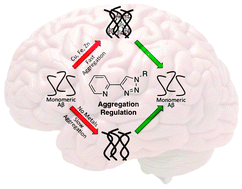Abstract
Dysregulated metal ions are hypothesized to play a role in the aggregation of the amyloid-β (Aβ)

- This article is part of the themed collection: Metallomics Emerging Investigators
Maintenance work is planned for Wednesday 1st May 2024 from 9:00am to 11:00am (BST).
During this time, the performance of our website may be affected - searches may run slowly and some pages may be temporarily unavailable. If this happens, please try refreshing your web browser or try waiting two to three minutes before trying again.
We apologise for any inconvenience this might cause and thank you for your patience.
* Corresponding authors
a
Department of Chemistry, Simon Fraser University, Burnaby, BC, Canada
E-mail:
tim_storr@sfu.ca
b Department of Chemistry, University of Michigan, Michigan, Ann Arbor, USA
c Biophysics, University of Michigan, Michigan, Ann Arbor, USA
d
Life Sciences Institute, University of Michigan, Michigan, Ann Arbor, USA
E-mail:
mhlim@umich.edu
Dysregulated metal ions are hypothesized to play a role in the aggregation of the amyloid-β (Aβ)

 Please wait while we load your content...
Something went wrong. Try again?
Please wait while we load your content...
Something went wrong. Try again?
 Fetching data from CrossRef.
Fetching data from CrossRef.
This may take some time to load.
Loading related content
